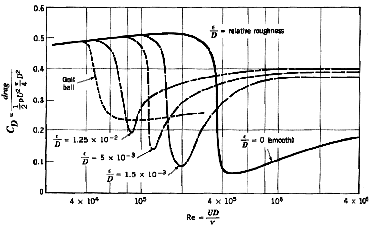Golf Balls, Cricket Balls and Tennis Balls
Golf Balls, Cricket Balls and Tennis Balls
Tripping the boundary layer to reduce drag on spheres is widely used in sports. For
example, it is the reason why golf balls are dimpled. The dimples act like a very
effective trip wire, and the reduction in drag due to the delayed separation allows the
ball to travel further for the same effort. A driver shot in golf can easily make a
golf ball carry 250 yards, but the same shot using a smooth ball will only carry about
100 yards. Similarly, a tennis ball has a textured surface with a convoluted seam, much
like a baseball. Figure 6 shows how effective different degrees of
roughness can be in reducing the drag on a sphere.
 |
|
Figure 6. Drag coefficient as a function of Reynolds
number for spheres with different degrees of roughness. From Munson, Young & Okiishi, Fundamentals of Fluid Mechanics, John Wiley & Sons,
1998. |
Cricket balls are slightly different to golf, tennis and baseballs. A cricket ball has a
single, circumferential seam which looks remarkably like a trip wire. If a cricket ball
is launched without spin so that the seam is tilted forward on the top of the ball, then
the boundary layer over the top surface becomes turbulent, whereas the boundary layer on
the bottom surface remains laminar. The wake becomes asymmetric, and a downward force is
produced so that the ball dips sharply. A similar effect can be obtained with a baseball
if the seam is held correctly.
The addition of spin complicates this picture enormously.
Spin can produce a side force on a ball due to the
Magnus effect. The effect of spinning the ball can depend strongly on the orientation of
the seam. Knuckle ball pitchers typically pitch a baseball with very little spin, and
they rely largely on the uneven tripping of the boundary layer. However, even a little
spin will make the direction of the side force change dramatically, and it is no wonder
that the behavior of a knuckle ball is highly unpredictable.
To learn more about these matters, see the article by Dr. Rabi Mehta of
NASA-Ames, entitled ``Aerodynamics of sportsballs,'' Annual Review of Fluid
Mechanics, 17:151--189, 1985.
Return to Aerodynamics of Bicycles Introduction.